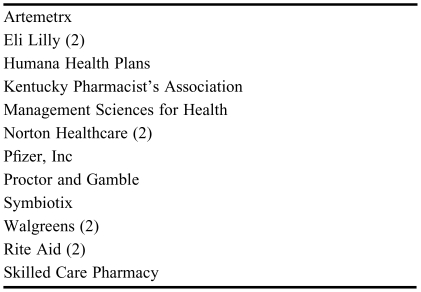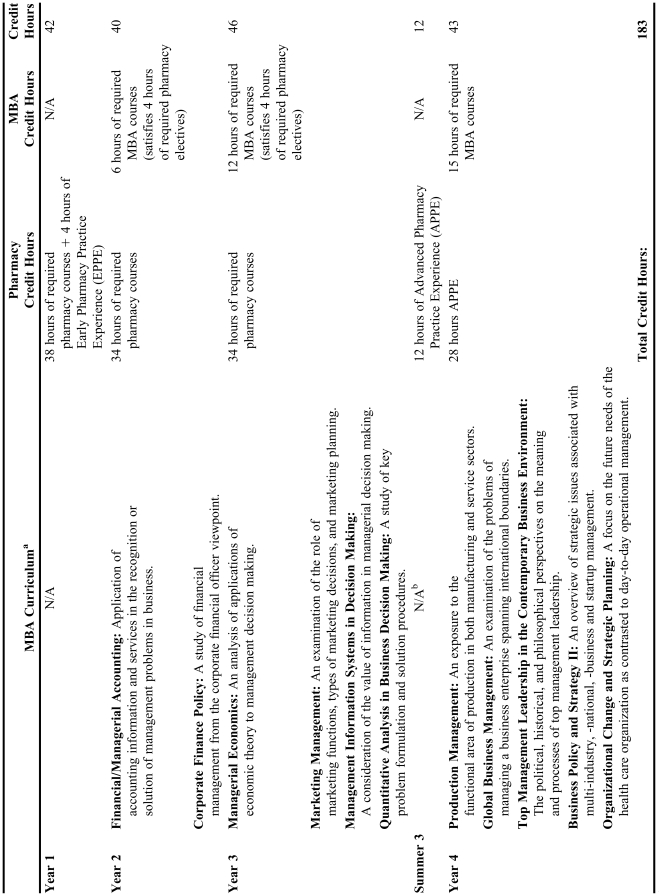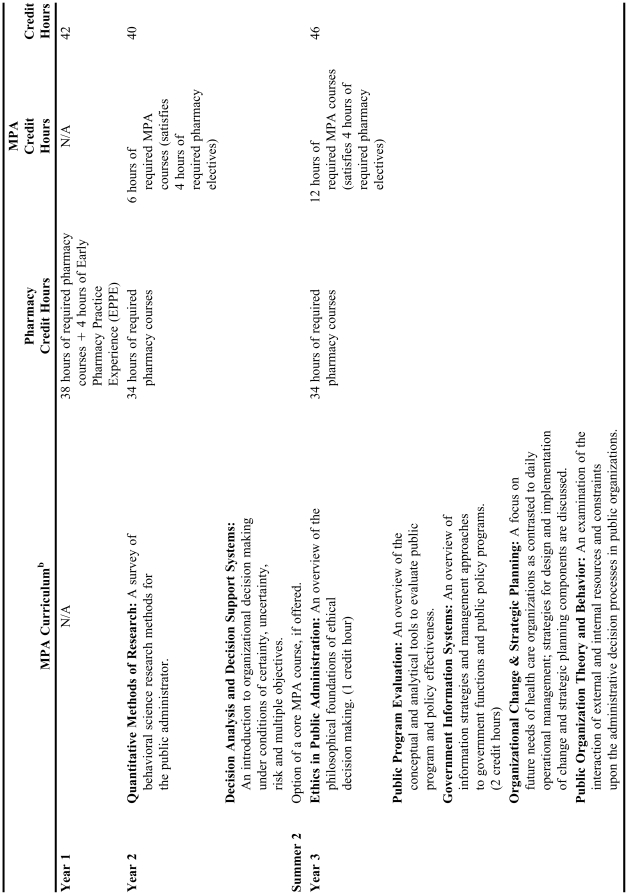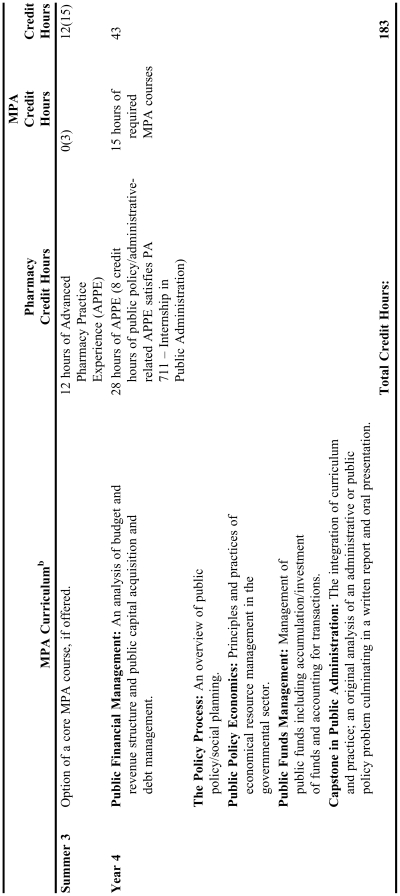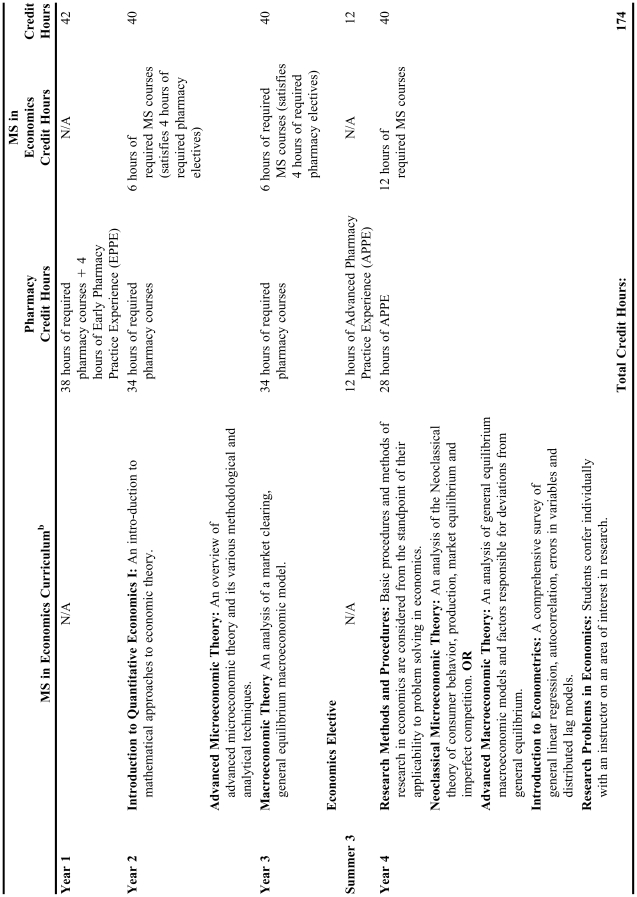Abstract
The rapid growth and evolution of the pharmacy profession has created a wide array of opportunities for graduating pharmacists beyond traditional community pharmacy or hospital practice. Management and leadership positions in federal and state healthcare agencies, pharmaceutical companies, hospitals, retail pharmacies, academia and managed care organizations increasingly require the pharmaceutical knowledge obtained through a doctor of pharmacy (PharmD) degree combined with financial, organizational, and management skills. In these innovative positions, pharmacists are being called upon to assume responsibilities as executives and administrators in systems providing pharmacist care services to patients.
To endow students with knowledge and skills required to perform the duties required in these decision-making positions, the University of Kentucky College of Pharmacy has established 3 joint degree programs: the PharmD/Master of Business Administration (PharmD/MBA), PharmD/Master of Public Administration (PharmD/MPA), and PharmD/Master of Science in Economics (PharmD/MS). This paper describes these joint degree programs.
Keywords: dual degree, joint degree, education, doctor of pharmacy degree, master of business administration, master of public administration
BACKGROUND
Joint degree programs have been offered at medical and nursing schools for more than a quarter of a century.1-4 Several medical colleges in the United States offer joint degree programs combining the medical degree with such degrees as the Master of Business Administration (MBA) and PhD.1-3 With the acceptance of the joint degree programs in medicine, schools of nursing also established joint degree programs, combining the Master of Science in Nursing (MSN) with the MBA. 4
A review of the literature on joint degree programs reveals few publications specific to programs in pharmacy. Searches of MEDLINE and International Pharmaceutical Abstracts (as of June 2007) identified only 5 papers that mention joint degree programs in pharmacy. Two of the papers discuss the PharmD/MBA program at the Bernard J. Dunn School of Pharmacy, Shenandoah University.5,6 McKay, Stull, and Robinson5 provide a brief synopsis of the creation of the joint PharmD/MBA at Shenandoah, while Latif and Wachsmann6 describe a specialized management rotation for students enrolled in the program. Student satisfaction and academic performance in the PharmD/MBA program between the South Carolina College of Pharmacy and The Citadel's School of Business Administration are documented by Chumney and Ragucci.7 A descriptive snapshot of 14 of the 15 active PharmD/MBA programs as of 2002 is provided by Thai and Draugalis.8 The only joint degree article in pharmacy that is not specifically focused on the PharmD/MBA option is the recent paper by Gourley and colleagues.9 These authors describe characteristics of PharmD/PhD programs offered in the United States with a focus on the program offered at the University of Tennessee.9 In addition to these 5 papers, International Pharmaceutical Abstracts documents 8 published abstracts on dual degree programs within pharmacy.10-17 Again, the emphasis is placed on programs offering a PharmD/MBA and/or PharmD/PhD.
It is somewhat surprising that information on joint degree offerings in colleges and schools of pharmacy is in such short supply since the 2005 American Association of Colleges of Pharmacy (AACP) White Paper identified at least 41 colleges and schools of pharmacy offering some kind of joint degree program.18 Joint degree programs in pharmacy combine the doctor of pharmacy degree with such degrees as master of public health (MPH), master of business administration (MBA), master of public administration (MPA), master of science (MS), physician assistant (PA), juris doctor (JD), and doctor of philosophy (PhD). The AACP White Paper reports that most PharmD/PhD graduates enter academia. The PharmD/MBA graduates are less well described, but many are employed in managed care organizations and pharmaceutical industry.18 Little is known about the career paths for other joint degree program graduates.
The advantages of a joint degree in pharmacy lie both in timing and in the opportunities outside of traditional clinical or community pharmacy. Thai and Draugalis state that the dual degree differs from the MS residency or pharmacy practice management residency by being completed during the PharmD education.8 Thus, opportunity cost is reduced when compared to obtaining the second degree separately from the PharmD degree. Oakley reported that pharmacist managers with an MBA or MS were preferred for administrative positions in hospitals.19 In a separate survey, Oakley and colleagues found that only pharmacy directors with an MBA or MS degree believed they had been adequately prepared for their role as director through their academic training.20
The purpose of this paper is to contribute to the limited literature describing joint degree programs offered in colleges and schools of pharmacy in the United States by describing the programs currently offered at the University of Kentucky College of Pharmacy.
DEGREE PROGRAMS
To prepare students for the changing world of healthcare and pharmacy, the University of Kentucky College of Pharmacy has established 3 joint degree programs: the PharmD/MBA, PharmD/MPA, and PharmD/MS in Economics. All programs are established in cooperation with other schools or colleges on the UK campus. All cooperating schools and colleges are fully accredited by their respective accrediting bodies.
An information packet that includes descriptions of the joint degree programs is given to prepharmacy students and a brief presentation about the joint degree programs is given to first-professional year (P1) pharmacy students. Students may decide to apply for a dual degree program any time in their first year of pharmacy studies. There are required foundation courses for both the MBA and MS in Economics. In general, interested students must complete these with their prepharmacy courses.
The advantages of obtaining a dual degree at the University of Kentucky are similar to those listed above. Dual degree graduates possess additional knowledge and skills differentiating them from graduates with the PharmD alone; thus, they are potentially more attractive to employers and better prepared for positions in management, the pharmaceutical industry, academia, or managed care. One important aspect of the dual degree programs at the University of Kentucky compared to those at other institutions is that no additional tuition costs are incurred while the student is enrolled full-time in the College of Pharmacy. According to the AACP White Paper, the University of Kentucky is 1 of only 2 institutions to offer this incentive.18
The dual degree programs are designed to be easily integrated with the PharmD curricular requirements. At the University of Kentucky, as a part of the PharmD curriculum, students complete an area of concentration known as the “Pathway Program.” To fulfill the Pathway requirement, students complete 8 credits of study in advanced level courses. Options within the Pathway Program include the joint degree programs in addition to concentrations in specialty areas such as geriatrics or pediatrics. Concentrations in specialty areas do not provide an additional degree; they are simply 8 credit hours of focused coursework in a specified area. The dual degree programs greatly exceed the number of credit hours needed to satisfy the Pathway requirements.
During their fourth-professional year, pharmacy students participate in 10 month-long advanced pharmacy practice experiences (APPEs). At the University of Kentucky, 5 APPEs are required and designed to expose students to the common areas of pharmacy practice; the remaining 5 APPEs are of the student's choosing. These elective APPE rotations allow students to tailor their experiences to their interests. In the case of those pursuing a dual degree, it allows for completion of an internship or research practicum, if required, and for the practical application of their specialized training. A number of other experiences are available, including those with pharmaceutical companies, hospital administration, insurance companies, independent pharmacy cooperatives, research departments, regulatory and public health agencies, and government affairs. Joint degree students are encouraged to arrange specialty rotations if their precise area or interest is not covered by an ongoing rotation. The specifics for each of the joint degree programs are further described below.
Joint PharmD/MBA Degree Program
The PharmD/MBA is offered in conjunction with the Gatton College of Business and Economics. The MBA program is accredited by the American Assembly of Collegiate Schools of Business. The goal of the joint PharmD/MBA program is to educate students to assume responsibilities as executives and administrators in health care delivery so that patients may receive quality pharmaceutical products and services.
The joint PharmD/MBA program was established in 1998. The program is directed toward providing didactic and experiential education to students that will allow them to understand the functions and behaviors common to all organizations. In the dual PharmD/MBA program, students take courses in accounting, economics, finance, marketing, and strategic management. As part of the dual degree, students are also given the opportunity to substitute some of the business management classes with classes offered in health administration and/or health services management. All MBA courses are offered in the evening so there are no conflicts with College of Pharmacy courses or APPE rotations.
By integrating the pharmacy and MBA programs, students are able to complete the dual program of study in 4 years. This is the same amount of time it takes students to complete the traditional pharmacy program alone. In contrast to some joint PharmD/MBA programs, summer coursework is not necessary to complete the program in 4 years at the University of Kentucky. Under the dual degree program, 3 hours of a pharmacy course satisfy MBA elective requirements. In turn, the College of Pharmacy allows up to 8 credit hours of MBA coursework to count as elective credits toward the PharmD. Recently, the MBA program has implemented a case competition which the student must take part in. The case competition is not part of any particular MBA course, but instead, serves as a capstone for the program. The goal of the competition is to encourage students to integrate various concepts from the MBA courses into one case rather than take a comprehensive examination for the entire program. Appendix 1 provides an overview of the course requirements and typical schedule for students in the PharmD/MBA program.
Joint PharmD/MPA Program
The PharmD/MPA program is offered jointly with the James W. Martin School of Public Policy and Administration. The MPA program is accredited by the National Association of Schools of Public Affairs and Administration. The dual degree is designed to prepare students for careers in state and federal regulatory and administrative agencies, not-for-profit organizations, the pharmaceutical industry, managed care organizations, and academia. Courses focus on quantitative analysis, leadership, interpersonal skills, budgeting systems, operations, policy formulation/implementation/analysis, and effective written and oral communication.
The interface between public administration and pharmacy administration was recognized in 1976.21 Two decades later, the PharmD/MPA dual degree program at the University of Kentucky became the first degree-granting integration of the 2 disciplines in the nation. The dual degree program is designed to enable students to obtain both the doctor of pharmacy and the master of public administration degree using a time efficient approach. As with the dual MBA, students can complete both degrees in 4 years without required summer courses. The number of credit hours necessary for graduation is decreased to 183 from the 203 necessary to complete each degree individually. All MPA courses are offered in the evening so there are no conflicts with College of Pharmacy courses or APPE rotations.
The combined PharmD/MPA curriculum is intended to cultivate pharmacists who are uniquely prepared to develop, implement, and evaluate drug policy in the challenging and evolving health care market. The core course work involved in completing the MPA portion of the dual degree consists of quantitative methods of research, decision analysis, public financial and funds management, organizational theory, and public policy economics. Appendix 2 provides an overview of the required MPA courses and the typical schedule for a PharmD/MPA student. All courses listed are considered to be core, or required, for completion of the degree.
As a part of the PharmD/MPA program, students must complete a 2-month internship. This internship can be in a private for-profit institution/setting, a public institution/setting, or a not-for-profit institution/setting. The objective of this internship is to allow students to combine their pharmacy knowledge and skills and their policy analysis and administration knowledge. The internship usually serves as the setting for data collection or initiation of research for a capstone project, which is a requirement for graduation from the MPA program. The capstone allows students to integrate their didactic learning with professional practice by analyzing management and policy problems.
Joint PharmD/MS in Economics Program
The dual PharmD/MS in Economics degree, offered in conjunction with the Gatton College of Business and Economics, provides students with the strong analytical skills necessary to ensure that resources are being utilized in an efficient manner within the health care sector. The dual PharmD/MS in Economics provides excellent preparation for initial employment as an analyst/researcher in government or private businesses.
Students are able to complete the dual PharmD/MS in Economics degree in 4 years of full-time study. Under the dual degree program, 6 of the 30 hours for the MS program are satisfied by pharmacy course work. In addition, 8 credit hours from the MS course work are applied to elective credits in the College of Pharmacy. The dual degree curriculum includes courses in microeconomics, health economics, research methods and procedures, and econometrics. After completion of all course work in the dual degree program, students must also successfully complete a final examination confirming their competency in economics. Appendix 3 presents a typical course of study for the PharmD/MS in Economics program.
GRADUATE AND STUDENT PERCEPTIONS
In an effort to assist prospective joint degree students in choosing a pathway in the dual degree program, the College of Pharmacy periodically conducts an informal survey of former joint degree graduates and students currently enrolled in the joint programs. While not structured as a satisfaction survey, as described by Chumney and Ragucci,7 the information gathered in these surveys is utilized to promote and further develop the joint degree programs at the University of Kentucky. Survey questions are shown in Appendix 4.
The most important factors in choosing the dual degree pathway for students and graduates are the ability to finish both degrees at the same time; no extra tuition for the added degree; and the greater opportunities made available upon graduation with the joint degree. One of the most interesting comments from students in these programs is that they enjoy having classes with students outside of the pharmacy program. They perceive a real benefit from the group work with students from business and social-science backgrounds and they enjoy the opportunity to discuss topics outside the realm of pharmacy.
Students pursuing the joint degree programs are typically seeking careers in a nontraditional pharmacy setting or management. Many note their desire to work for the pharmaceutical industry. The joint degree is viewed as an opportunity to enhance their skill set for their future career and as an opportunity to distinguish themselves from other PharmD graduates.
A frequent comment from survey respondents is that they would like to learn more about the joint programs earlier in their pharmacy training. Specific information that students and graduates would like includes: career options and opportunities available after graduation; level of difficulty in completing the dual degree program; “real world” application of material learned in dual-degree classes; personal “testimonials” from current students and graduates of the dual-degree programs; and course availability. One student added that it would have been beneficial to have greater access to detailed information about the dual-degree programs prior to entering pharmacy school so that necessary prerequisites could have been completed along with the pharmacy prerequisites.
A number of steps have been taken to address these comments. The College of Pharmacy now lists joint degree programs as a separate item under the “Information for Prospective Students” bullet on the website (http://www.mc.uky.edu/Pharmacy/acaffairs/preps_j.asp). In-depth information for current students on the dual degree options is provided via a variety of venues. One College of Pharmacy convocation each year is devoted to the joint-degree programs, where current students and/or graduates discuss their experiences with the programs. An informational “brown bag” lunch session is scheduled at the beginning of each academic year to introduce first-professional year students to the various joint-degree options. This session is followed-up in the spring semester with a formal presentation during a class-lecture in the Introduction to Pharmacy Practice II course. Including current dual-degree students in these presentations appears to be a key factor in stimulating student interest in the dual-degree options.
ASSESSMENT
Experience With PharmD/MBA Program
As of 2006, 5 students have graduated from the PharmD/MBA program, and 6 are currently enrolled. Prior to formalizing the joint-degree program, 1 pharmacy student completed both the PharmD and the MBA degrees concurrently. This represents a substantially lower uptake of the degree than at the Bernard J. Dunn School of Pharmacy where over 10% of the entering pharmacy class chooses the joint-degree program.5
Of the 5 graduates who have completed both the PharmD and MBA degrees, one is a staff pharmacist for a cardiac hospital, one is managing 2 independent pharmacies, and another is the director of an outpatient pharmacy for the United States Army. As the Officer-in-Charge of outpatient pharmacy, this graduate stated that the dual-degree program prepared him for his position by educating him in the principles of supervising personnel, managing a multimillion dollar budget, and administering the policies and procedures of a pharmacy operation. He stated, “This (his position) is exactly what the dual degree was preparing me for, both the medical and business aspects of pharmacy.” Another PharmD/MBA graduate emphasized that even though he does not utilize his MBA degree extensively in his current job, he does use it in his everyday life. He explains that by completing both the PharmD and the MBA, he has become a better manager of his time and his own personal finances.
Both the graduates and current students of the dual PharmD/MBA view the program as an opportunity they could not refuse. The ability to finish both the pharmacy and business degree at the same time without paying any extra tuition is seen as an incredible opportunity and was the most important factor for choosing the dual degree. Students in the program agree that the joint degree program will give them a competitive edge in the pharmacy profession, and recent PharmD/MBA dual degree graduates support this by obtaining management or advanced positions as new graduates.
Experience With the PharmD/MPA Program
The University of Kentucky has 16 graduates of the joint PharmD/MPA program. This represents approximately 2% of the total College of Pharmacy graduates from 1999-2006. On average, 2 students graduate each year; however, it appears that interest in the program is highly variable by class, with a maximum of 4 graduates in 2000 and 2005 and a minimum of 0 graduates in 2002 and 2003. Eight students were enrolled in the program as of 2007.
Capstone projects from PharmD/MPA students have analyzed a number of pharmacy-specific policies and issues. Appendix 5 contains a list of PharmD/MPA graduates' capstone projects through 2006.
The graduates of the PharmD/MPA program have obtained positions such as senior program associate, outcomes research manager, pharmacy co-manager, and medical regulatory associate at a wide range of organizations (Table 1). Graduates manage a vast array of responsibilities including supervising organizational projects, conducting sales analyses, designing and interpreting research studies, overseeing retail pharmacy affairs, and providing guidance to project teams. The dual PharmD/MPA degree prepared many of these graduates by helping them learn multiple task management, time management, and personnel assessment. One graduate stated that she might never have learned about some pharmacy positions, including her current position, if it had not been for the dual degree program. Another student said, “I can safely say that every class I took in the Martin School (MPA program) has provided me with information I use in my job. I have all of my textbooks in my office for reference.”
Table 1.
Employers of PharmD/MPA Graduates
For current students and recent graduates of the dual PharmD/MPA program, a wide range of factors were important in choosing this pathway. The availability of class time and no extra fees or tuition were important issues for many students, while others viewed the dual degree program as an opportunity to expand their career options. One graduate with a strong interest in health services research saw the MPA program as a way to fulfill this interest. Both current students and graduates agreed that the profession of pharmacy is changing and that the dual PharmD/MPA degree will result in more qualified pharmacists who have clinical, administrative, and managerial expertise. One student explained that having the ability to use pharmacy and policy knowledge would benefit both fields. A graduate of the program took this a step further and said, “Pharmacy is not an isolated profession, and it shouldn't be. Pharmacy is related to anthropology, public health, psychology, law, business, policy, administration, information management, etc…and a person who has knowledge of any of these 2 combinations can help the profession grow and give even more value to society.”
Experience With the PharmD/MS in Economics Program
As of July 2007, no student has enrolled in the PharmD/MS in Economics program. There may be several reasons for this. One reason could be that the MS in Economics has not been promoted to the same extent as the other joint degree programs within the College of Pharmacy. Another reason may be the perception that opportunities with this degree are more limited compared to the broader opportunities offered by other joint degrees. Finally, the prerequisites for this program are significant and require a large concentration of undergraduate economics coursework, which most pharmacy students do not have.
DISCUSSION
For decades, health professionals grounded in business management, policy analysis, and clinical skills have been recognized as providing an important and unique interface between health care practitioners, managers, and bureaucrats to balance clinical decision making with bottom line financial realities.22-28 Individuals with strong management and business skills in combination with clinical knowledge are compelling assets for any organization seeking to keep health care costs under control. Leaders in health care must be able to integrate cost containment with resource and personnel management principles, fulfill legal and contractual requirements, and develop patient assistance and professional training programs, all while maintaining high standards of quality care.19-28 Many have suggested that ideal leaders for the modern health care market are health professionals, including pharmacists, educated in management, policy, and financial strategies.19-28
Some career opportunities for pharmacists require additional education and skill development beyond what is obtained in the PharmD program. Nationally advertised pharmacy management positions tend to require or prefer advanced degrees.29 At the University of Kentucky, combined PharmD/MBA, PharmD/MPA, and PharmD/MS in Economics programs have been designed to provide students with clinical, business, administrative, policy analysis, and fiscal capabilities required to excel as leaders in the future health care system.
Appendix 1 Typical Program of Study for PharmD/MBA Degree at the University of Kentuckya
Appendix 2 Typical Program of Study for PharmD/MPAa
Appendix 3 Program of Study for PharmD/MS in Economicsa
Appendix 4. Joint Degree Survey Questions
Please complete the following questions.
What factors were important to you in choosing the joint degree program?
What has been the most interesting aspect of the joint degree program?
What are your plans after graduation?
How do you feel the joint degree program will assist you in completing your career goals?
What specific information would have been helpful for you when you decided to pursue the joint degree program?
Is there anything else that you would like to share with us?
Appendix 5. Capstone Projects from the Dual PharmD/MPA Program at the University of Kentucky
“Kentucky Medicaid Health Care Partnership Program: Passport Health Plan Pharmacy Costs” (1999)
“Impediments to Disproportionate Share Hospitals in Administering the 340B Legislation” (2000)
“Pharmacy Costs and Utilization of Osteoporosis Therapy in a Managed Care Plan” (2000)
“The Use of Atypical Antipsychotic Medications in Public Psychiatric Hospitals in Kentucky” (2000)
“The Importance of Medication Compliance: A Health Insurer's Perspective” (2000)
“Analysis of Medicare Policy Governing Pharmacist Reimbursement for Diabetes Education” (2001)
“Prescription Drug Abuse: How Can a Managed Care Organization Curtail This Problem and Benefit Members?” (2001)
“An Analysis of SF-12 Quality of Life Measures within a Managed Care Provider Group” (2004)
“Off-label Olanzapine Prescribing and the Prevalence of Schizophrenia and Bipolar Disorder” (2004)
“Level of Pharmacy Practice and Satisfaction after the Introduction of the PharmD as the Sole Entry-Level Degree” (2004)
“Disease Management Programs: Are They an Effective Tool to Control Healthcare Costs?” (2005)
“Do Specialty Pharmacies Improve Compliance within Health Plans? A Case Study of Bluegrass Family Health Rheumatoid Arthritis Patients” (2005)
“A Model of the Effects of Prior Authorization Requirements on Gabapentin Spending in the Kentucky Medicaid Population” (2005)
“The Effects of a University-Based Academic Detailing Program for Primary Care Providers on Hemoglobin A1c Assessment Frequency in Type II Diabetes” (2005)
“Kentucky Pharmacists' Perceptions on Medication Errors”. (2006)
“Un-reimbursed Emergency Department Costs Incurred by Hispanic Workers and Their Dependents in Central Kentucky” (2006)
REFERENCES
- 1.Shalowitz JI, Nutter DO, Snarr JF. Medicine and management: a combined educational program. J Health Admin Educ. 1996;14:305–13. Summer. [PubMed] [Google Scholar]
- 2.Thorne S. Medical schools seeking new ways to cope with funding cutbacks. Can Med Assoc J. 1997;156:1611–3. [PMC free article] [PubMed] [Google Scholar]
- 3.McClellan DA, Talalay P. M.D.-Ph.D. training at the Johns Hopkins university school of medicine, 1962-1991. Acad Med. 1992;67:36–41. doi: 10.1097/00001888-199201000-00008. [DOI] [PubMed] [Google Scholar]
- 4.Minnick A, Weisman CS, Curgian L. The acceptance and growth of MSN/MBA programs. J Nurs Admin. 1994;24(11):63–8. doi: 10.1097/00005110-199411000-00013. [DOI] [PubMed] [Google Scholar]
- 5.McKay A, Stull R, Robinson E. Anatomy of a Pharmacy School Startup: Part 3. J Pharm Teaching. 2004;11:65–114. [Google Scholar]
- 6.Latif DA, Wachsmann HO. A specialized management rotation for dual PharmD/MBA candidates. Am J Pharm Educ. 2003;67(2) article 36. [Google Scholar]
- 7.Chumney EC, Ragucci KR. Student satisfaction and academic performance in a dual PharmD/MBA degree program. Am J Pharm Educ. 2006;70(2) doi: 10.5688/aj700229. Article 29. [DOI] [PMC free article] [PubMed] [Google Scholar]
- 8.Thai A, Draugalis JR. Dual PharmD/MBA programs 2001-2002: a descriptive report. Am J Pharm Educ. 2002;66:372–7. Winter. [Google Scholar]
- 9.Gourley DR, Rowell C, Wingate L, Yates CR, Vleet V, et al. Status of PharmD/PhD programs in colleges of pharmacy: The University of Tennessee dual PharmD/PhD program. Am J Pharm Educ. 2006;70(2) doi: 10.5688/aj700244. Article 44. [DOI] [PMC free article] [PubMed] [Google Scholar]
- 10.Hollenbeck RG. Enabling careers in academic pharmacy [abstract]. 103rd Annual Meeting, July 14-17, 2002, Kansas City, Missouri. Am J Pharm Educ. 2002;66(Suppl):101S. [Google Scholar]
- 11.Blumenschein K, Toma EF, Lubawy WC. Combined Doctor of Pharmacy and Masters of Public Administration degree program [abstract]. 99th Annual Meeting: July 18-22, 1998, Snowmass Village, Aspen, CO. Am J Pharm Educ. 1998;62(Suppl):84S. [Google Scholar]
- 12.Harris WT, Pollock SH, Binnicker PC, Holbrook JM, Matthews HW. Development of a joint PharmD/PhD program [abstract]. 95th AACP Annual Meeting: July 16-20, 1994, Albuquerque, NM. Am J Pharm Educ. 1994 [Google Scholar]
- 13.Boyd JA, Zinkhan FC. AACP Annual Meeting; 1993. Campbell University joint Doctor of Pharmacy/Master of Business Administration program [abstract] 94(Jul); VII-1. [Google Scholar]
- 14.Latif DA, McKay AB. Future of pharmaceutical education at Shenandoah University [abstract]. AACP Annual Meeting. 2000;101(Jul):307. (abstract) 101st Annual; Meeting, July 7-12, 2000, San Diego, CA. Am J Pharm Educ. 2002;64(Suppl):132S. [Google Scholar]
- 15.Lubawy WC, Yokel RA, Blouin RA, Blumenschein K. Advanced degree programs integrated with the Doctor of Pharmacy curriculum as a foundation for the future[abstract]. AACP Annual Meeting. 2000;101(Jul):307. (abstract) 101st Annual; Meeting, July 7-12, 2000, San Diego, CA. Am J Pharm Educ. 2002;64(Suppl):129S. [Google Scholar]
- 16.Leslie SW, Davis PJ, Littlefield LC, Richards J, Solis A, et al. Academic leadership development at the University of Texas. [abstract]. 103rd Annual Meeting, July 14-17, 2002, Kansas City, Missouri. Am J Pharm Educ. 2002;66(Suppl):104S. [Google Scholar]
- 17.Scimeca SG, Owens NJ, Hume AL. Academic longitudinal rotations [abstract]. 103rd Annual Meeting, July 14-17, 2002, Kansas City, Missouri. Am J Pharm Educ. 2002;66(Suppl):103S. [Google Scholar]
- 18.Nelson S, Andritz M, Davis P. Dual Degree Task Force White Paper. Available at: http://www.aacp.org/site/page.asp?TRACKID=&VID=1&CID=1046&DID=6137. Accessed on January 28, 2008.
- 19.Oakley RS. The preferred degree for administrative positions in hospital pharmacy departments. Am J Pharm Educ. 1985;49:55–8. [PubMed] [Google Scholar]
- 20.Oakley RS, Bradham DD, Kimberlin CL. Evaluation of the education of hospital pharmacy directors. Am J Pharm Educ. 1985;49:277–81. [PubMed] [Google Scholar]
- 21.Larson LN, Smith MC, Hy RJ, McArthur RE. Interface of Public administration and pharmacy administration. Am J Pharm Educ. 1976;40:65–7. [PubMed] [Google Scholar]
- 22.Brady R. RPh plus MBA: new synergism. Am Drug. 1980;182 18, 20. [Google Scholar]
- 23.Anon. What can a business degree do for me? Pharm Bus. 1991; 2: 28-9.
- 24.Rodowskas CA. Is there an M.B.A. in your future? Pharm Times. 1990;56:81–5. 89–90. [Google Scholar]
- 25.Gannon K. M.B.A. degrees: how important are they? Drug Top. 1988;132 80;83. [Google Scholar]
- 26.Lipman AG, Blair JN. Graduate program in institutional pharmacy management leading to an MS in Hospital Pharmacy, MBA and residency. Am J Pharm Educ. 1981;45:17–20. [PubMed] [Google Scholar]
- 27.Rajah DT. Mulling over an MBA. Chem Drug. 2000:253–28. [Google Scholar]
- 28.Gannon k. Mini MBA programs bolster pharmacy management skills. Drug Top. 1993;137:26–7. [Google Scholar]
- 29.Wieland LD, Murphy JE. Academic and training requirements in advertisements for pharmacy management and clinical positions. Am J Health Syst Pharm. 1996;53:289–93. doi: 10.1093/ajhp/53.3.289. [DOI] [PubMed] [Google Scholar]



